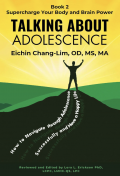

LitPick Review
Talking About Adolescence: Supercharge Your Body and Brain Power by Ms. Eichin Chang-Lim is an educational book about transitioning from childhood to adulthood in the best body and mind. It reveals how we can maintain mental, physical, emotional, and social well-being during this change. Talking About Adolescence is a book that is focused basically on adolescents. It is divided into three parts, making it easier for readers to learn about what it means to move from childhood to adulthood. The first part explains in detail the journey during this period, how it starts from puberty, the body and hormonal changes to expect, and it enlightens readers more on pregnancy and parenting. The second part focuses on the brain. It addresses the changes the brain passes through during this transformation and how it contributes to growing up. The brain was explored as one of the parts that undergoes development and reorganization during the stages of growth. Apart from that, the author included various addictions that could begin during this stage and their effect on the brain. The third and last part focuses on supercharging the body and brain. It reveals how our mental health can have an effect on our growth, and it sheds light on how we can deal with our mental health and past traumas. It also includes how bringing out the confidence in you can go a long way in developing your body and brain.
Opinion:
First, the book was very educational. It was focused on adolescents, but its contents are beneficial to young teens and even adults. For instance, I gained a lot of knowledge about my brain and how it reorganizes as I grow. I also learned about how to deal with and improve my mental health. Lastly, I loved the part that elucidates addiction. Not only did I learn the effects of certain addictions on the brain, I was also exposed to different addictions such as substance intake that is popular among young people.
Second, the author's style of writing was analytic. What does this entail? Topics concerning adolescence can be considered complex, but the author made her content easier to grasp by including descriptions and definitions of words like executive function, which might not be understandable to certain readers. The information included in the book was provided in a clear way, benefiting both young and old readers. Besides the clarity of the information in the book, the author's use of evidence is one thing that made me like the book more. She supported her writing with adequate study, research, diagrams, and opinions from popular figures like Dwayne Johnson and Demi Lovato. She even incorporated links to websites, videos, and references from which a particular definition or quote was obtained. Still on the analytic writing of the author, I appreciated how the author kept a neutral tone on the suggestion concerning whom we can direct our prayer to. On page 244, she did not specifically mention who we should pray to, but she said, “If you believe in a higher power, you may pray and ask God or the universe for wisdom…”
The book possesses some unique features such as vivid pictures of the brain, reproductive organs, and others to enable readers to understand their body. Each chapter begins with questions to ponder on and ends with reflections from each chapter. I really like this because it helps retain what I have learned. What I came to love the most was how the author added quotes from famous people. It is a way of telling the readers that these celebrities are not perfect as some might think and that their body and mind undergoes the same changes we experience. It also installs in the mind of the readers that they are not alone in their journey to adulthood. Finally, from page 255, we see the appendices where we get references of links and quotes used in the book. I learned a lot from reading this book, and I would gladly recommend this book to young teens, young adults, and mature adults since they would have a lot to learn too.

